Unfortunately the perpetually grinning, carefree black man was one of the oldest negative stereotypes about African-Americans. That distorted caricature was called a Sambo. He was always happy but had no desire for work. By making the black characters happy and one-dimensional it was easy for bigots to think of them as less than human. The Sambo was created during the final years of slavery in the United States. Half a century after slavery had been abolished that image had permeated US culture to the point that the grinning figure was seen on advertising, in cartoons and even on household items. It was not until the civil rights movement that the mass consciousness grew to accept that the image was demeaning and hurtful to an entire population. Products lost the offensive art and black characters began to be drawn more realistically by advertisers. People the world over did not get that memo however. They did not experience the civil rights movement and had no idea what was to be considered offensive. They may have assumed that this was an acceptable way to present black characters.

There was a period of time where I wondered if Sega were capable of introducing a black character into an arcade game that was not perpetually grinning. The games the characters appeared in were very well done but the minority characters looked tokenized. This was not an issue exclusively with Sega. When many Japanese studios began incorporating black characters into their games they went to the long standing designs from the West. In some cases they did not dig deeper than recreating the look of popular athletes and actors from the late '80s and early '90s. The controversial NBA player Dennis Rodman and action movie star Wesley Snipes were just two people that ended up inspiring a series of characters through the golden years of the fighting game genre.
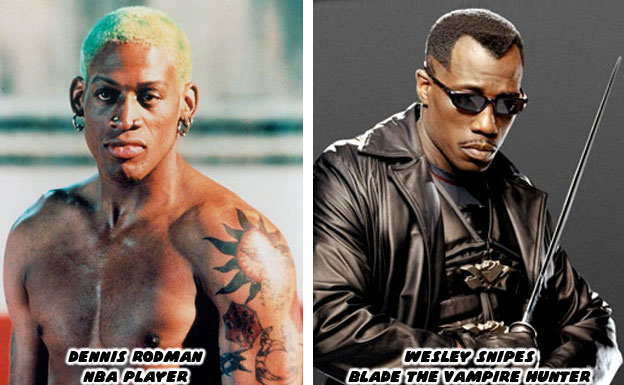
Being a black wasn't enough to make the character unique to the Japanese developers. The characters almost universally had to be very "cool," almost to the point that they were too cool to be seen in the game itself. How did the developers accomplish this? Quite simple, they often gave black characters sunglasses and unique hair styles. Sometimes they would even have gold teeth. Truly right out of a rap video! Rare and unique fighting arts were often assigned to all of the other characters but it often seemed secondary to black fighters. They had to appear cool first and foremost or else audiences would not know what to make of them.
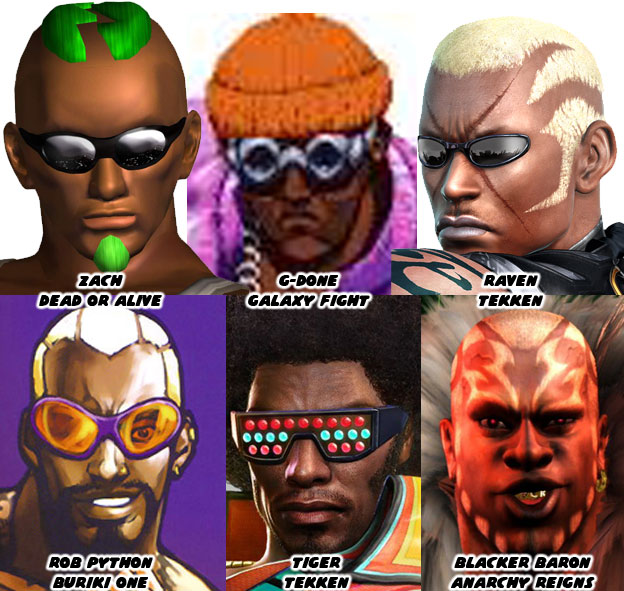
Sega, Capcom, Namco, Square-Enix and SNK were some of the Japanese publishers that ended up running with the skewed look at minorities. By making a non-threatening black person the studios thought they were showing diversity. The colored characters were like cartoon mascots however, emotionless and simply there to make people feel good about diversity. The fighting genre never had a Sambo, although Dee Jay from Super Street Fighter II certainly came close. The character wore a perpetual grin and danced with maracas whenever he won a fight. No other fighter in the series had ever carried such a silly expression while battling or celebrated with dubious overtones. The celebratory dance of Dhalsim though, whose head shaking and wide armed gyrations could have been considered as culturally insensitive and out of place.
DeeJay was actually designed and named after James "DJ" Goddard, a former Capcom USA employee. The Japanese therefor assumed that the character was appropriate. The basketball playing, breakdancing, fighters that emerged in the mid '90s could be considered leftovers from a less enlightened era. In the history of the US there were actually multiple racial caricatures that had been created to demean and dehumanize African-Americans. The Sambo was one of the earliest but the ones that followed became uglier and more widespread. The nicknames given to these representations of blacks were so grotesque that I wouldn't want to repeat them on this blog. There was an excellent documentary that explored the history of the stereotypical images. I would advise that everyone reading this blog should watch Ethnic Notions. Readers would be able to look at black character designs, especially in fighting games with a more critical eye thanks to the film.
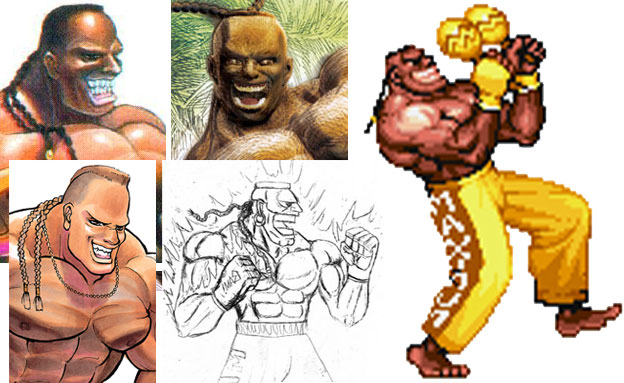
The defense sometimes used to explain characters like Dee Jay, Magic Dunker or Boggy were that the studios were simply trying to show the personality of the fighters from within the game. Many of the characters carried with them some sort of national pride. Guile was in the military and therefore the US Flag tattooed on his shoulders and camouflage pants made sense. Chun-Li was Chinese and had gone undercover in the fighting tournament so her pseudo-traditional costume also made sense. Like his namesake Dee Jay was a Jamaican entertainer first and foremost. He was a musician and happy about life in general. It just so happened that he was also a master of kickboxing and according to canon more powerful than the Thai boxers Sagat or Adon. Of course you would be hard pressed to find a game player that would consider Dee Jay a better character in canon or design. In context it was appropriate that Dee Jay carried maracas or a boombox with him wherever he fought. However the impact on gamers would have been wasted if the final boss in the original Street Fighter were a Jamaican layabout (that could not lose the ugly grin even in his sleep!) instead of a seven foot Thai boxer with an eye patch.
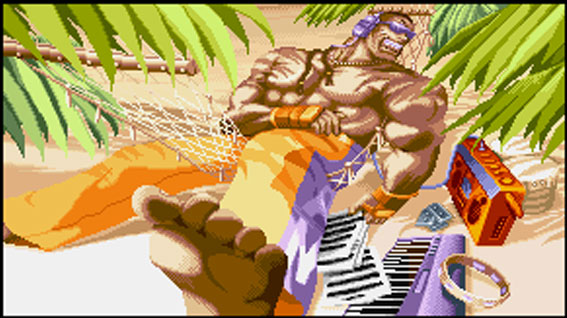
Dee Jay was inspired in part by martial artist and movie star Billy Blanks. Blanks had played an assortment of heroes and villains throughout his movie career but none were as lacking as Dee Jay. Aside from skin color and haircut there was not much that united the man and caricature. Dee Jay certainly skirted the line of Sambo. His carefree, perpetually grinning facade hid a lack of empathy and understanding about powerful black fighters and the ways they should be presented in gaming.
The Japanese studios by and large did not recognize that they could have associated a genuine fighting style with a minority character. It would not have offended the sensibilities of the game players. It would not have "broken" the game in any way. Characters like Dee Jay, Boggy, Ten Count, J. and Magic Dunker would have obviously remained black but their personality did not have to be dependent on sports or entertainment. Unfortunately the only alternative to basketball-playing fighters was to have those characters be arrogant, womanizing boxers.
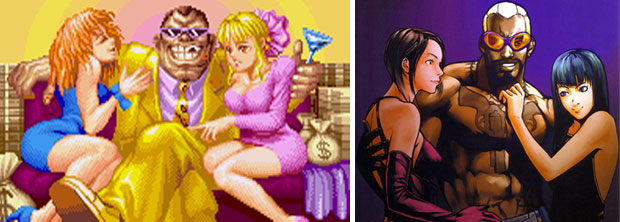
Again, if people in the West were offended by the image it was most likely because this was the mirror that Japan was holding up to them. In athletics the black man had been depicted as a brute, loudmouth or womanizer for the last half of the 19th century and the better part of the 20th century. Changing global perception would mean undoing almost 200 years of negative campaigning. Some of these myths were reinforced by actual personalities throughout history. Part of the stigma was due to the bravado of fighters like the legendary heavyweight champ Muhammad Ali and fighters that came before and after. Ali would put on press conferences denouncing the stereotypes perpetuated by his rivals. He would carry on with boisterous and very arrogant overtones. In the eyes of many he was as misrepresentative of black culture as he accused his opponents of being.
In the later part of the 20th century several fighters began combining that showmanship with demonstrations of excess. Fighters like Floyd "Money" Mayweather would flaunt their success, travel with full entourages and flash gold and money as if they were living out a rap video. Since it seemed that all of the boxing champs acted this way on television then the stereotypes must have been true. M. Bison, Joe Fendi and Rob Python were just a few of the black boxers presented in fighting games that reflected these images.
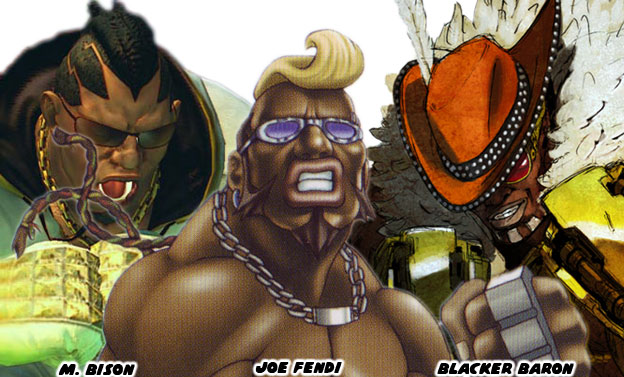
The Japanese developers were a little heavy handed with the pandering through most of the '90s. Black fighters in the games were almost all boxers. Yet it wasn't enough to be a boxer. These characters had to once again look and act cool otherwise audiences might not give them a chance. What could be cooler than boxers that wore sunglasses, jewelry and fought with gold and silver gloves? In the offshoot of the fighting genre, the brawler, the trope could not be escaped. The Blacker Baron from Anarchy Reigns was a revised version of a character that had appeared previously in Mad World. Both games were completely over-the-top and meant to shock players. In Mad World the Black Baron sported large lips and wore a "pimp" costume. I have been accused of being too sensitive to the portrayal of minorities in fighting games. But I have to ask if past a certain point is it not the responsibility of the gamer to ask why the characters have to appear this way?
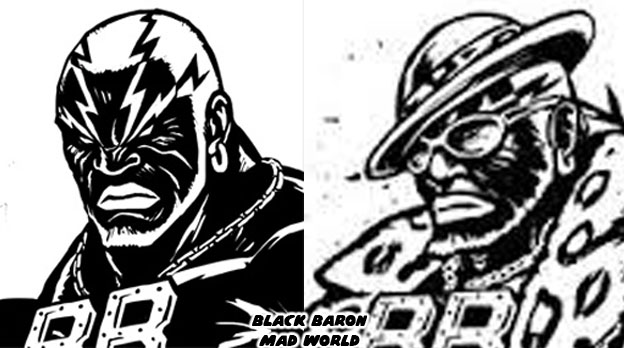
The Japanese designers seemed locked in a circular school of design. They would borrow points of reference from each other but never bother to venture outside of what they knew. The occasional bell bottoms and platform shoes here, or the big afro and sunglasses there. This was what it meant to be a black character right? They could not seem to break the mold when it came to black boxers. Even the characters for cancelled projects had the same aesthetics as designs from years later. The jewelry, the long pimp coat and exaggerated proportions were almost interchangeable between titles. It did not help that the wrestling and sometimes MMA promotions would have the black fighters wear costumes that perpetuated the stereotypes. The long coat with the fur trim, jewelry and sequins was not really from the "street" as much as it was from show business. The origins of the costumes did not seem to be a concern for the fans as long as they were being entertained.
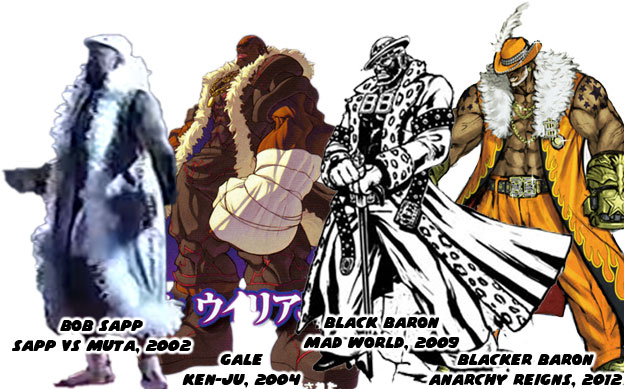
In order to make black fighters more endearing to Japanese audiences they often had to be very flamboyant. Dancing, entertaining and always smiling. The thing was that a one-time appearance like this from a big-name fighter, like football player-turned-mma-turned-pro wrestler Bob Sapp, would carry forward in game design for years and years. Japanese promotions were not the only ones to push a heavy handed stereotype on audiences. In the US the WWE had Mexican characters that rode lawn mowers and low riders and had to "lie, cheat and steal" in order to win. They had Irish wrestlers get accompanied to the ring by leprechauns. They had black pimp characters call out the Ho's so they could dance with them in the ring. Minorities had to have a gimmick first and foremost. In-ring talent was an afterthought.
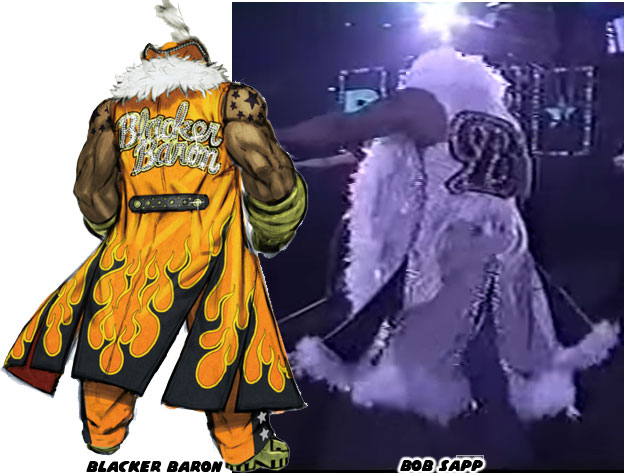
In other cases it was an attitude or even a hairstyle that would be most ingrained in the minds of Japanese developers. The contribution of black martial artists to wrestling and MMA would become secondary to a sneer.
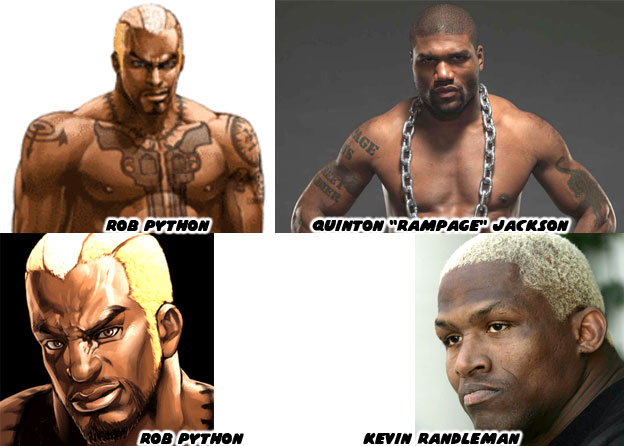
Not all of the studios were following these trends however. Some of the more memorable black fighting game characters were making waves in early 2D and 3D releases. The next blog will look at these pioneers. As always if you enjoyed this blog and would like to sponsor me please visit my Patreon page and consider donating each month, even as little as $1 would help make better blogs and even podcasts!

"It just so happened that he was also a master of kickboxing and according to canon more powerful than the Thai boxers Sagat or Adon" long time reader, first time commenter. I always wondered where in the canon is this stated. From my understanding of the material he beat the two in Alpha(Zero) 3 but in Sagat's and Adon's stories he's not mentioned
ReplyDeleteVoV, Thanks for your comment. I always thought it was weird that if he was such a powerful character why he had nothing to do in either Sagat or Adon's stories.
DeleteYea I think that was done specifically for Dee Jay's Alpha(Zero) 3 story because of him not having much outside of being a famous musician fighting to get new rhythms (whatever the hell that means lol). Thanks for the reply
DeleteOn an unrelated note, how do you feel about the EX characters being integrated into mainline SF canon via the SFV character encyclopedia?
ReplyDeleteI'm a little bit split on the decision. On one hand it's nice that the company is finally acknowledging that the characters exist and are part of Street Fighter continuity. I don't know if it's because ARIKA and Capcom mended bridges or because the new team didn't really know there was bad blood there. But I think of every chapter in Street Fighter as existing in its own pocket dimension. Technically none of the games have to be related, this would make more sense because EX was more about mystical characters and demons than science and dictators. But it's their characters, their call so I'll leave it at that.
DeleteI see what you mean in terms of the mysticism as opposed to the organizations plotting to rule the world. In that regard the EX series seems like it wanted to delve deeper into the Satsui no Hado. The inclusion of Shadaloo seems more fan service for SF fans than anything
Delete